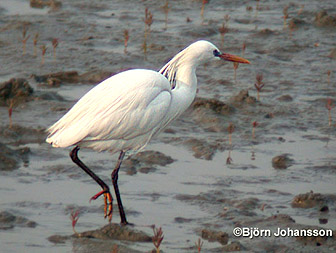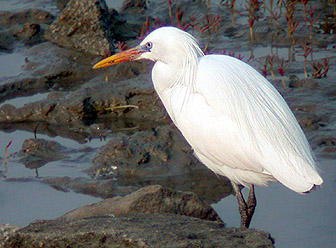
Rakish and superbly adapted to its tidal-flat niche, the porcupine-plumed Chinese Egret Egretta eulophotes remains to many birders a relatively unknown species, considered all too similar to other egret species, especially in non-breeding plumage. Perhaps due in part to this misperception, fueled by rather inaccurate portrayals in field guides (including Lee, Koo and Park [2000] and even the otherwise excellent Robson [2000]), the Chinese Egret's ecology and distribution remain relatively poorly known, and the species still does not receive quite the same high level of conservation interest as two other more famous Yellow Sea “specials”: the Saunders's Gull Larus saundersi and the Black-faced Spoonbill Platelea minor. On present, fairly limited, knowledge it is suspected that the Chinese Egret has a total breeding population of between only 2,400- 3,600 individuals and that it is declining, so it has been classified as Vulnerable by Birdlife International. It is further believed nowadays to be largely confined as a nesting species to the Yellow Sea (with a significant outpost in the Russian Far East), and that it winters southward to e.g. Vietnam, Malaysia and especially the Philippines - at all times being found almost exclusively on tidal-flats. In South Korea, where perhaps 600 – 1,000 breed on remote offshore islands [though note number now uncertain: Editors note, 2005], its name translates into English as “Orange-billed Egret”, further inviting popular confusion with more widespread species as structurally diverse and different as Cattle Egret Bubulcus ibis and Great Egret Egretta alba, even when its unique combination of orangey-yellow toes, black legs, deep orange bill, dark blue lores and spikey plumes make the bird's appearance as distinctive as it is beautiful. Contrary to most of the literature, the species also remains distinctive even in non-breeding and immature plumages, with experience relatively easy to pick out even at long range on its structure and feeding behaviour, and at closer range on its bare parts' coloration.
Found feeding only very occasionally in a broad range of other “egret habitats” such as rivers and rice-fields (and these mostly at high tide, near to the coast) the Chinese Egret feeds almost exclusively on extensive tidal-flats, with substrates ranging from silt-mud to mud-sand mix, although sand flats and sandy beaches are also sometimes used, especially during migration. Occupying a much narrower niche than the Little Egret Egretta garzetta, and largely shunning the rockier edges preferred by the Pacific Reef Egret Egretta sacra (especially in the north of the range), the Chinese Egret is by necessity extremely well-adapted to feeding in the extreme conditions of tidal-flats and estuaries – a habitat typified by variably soft substrates, highly turbid water, and harsh reflected light. With preferred prey of shallows' fish, small crustaceans and tidal-flat worms (though insects and other small items are also taken), the Chinese Egret's evolutionary adaptations to catch and feed on them include short tibia compared to most other egrets (allowing it to run more swiftly than potential competitors) and a well-defined skeletal ridge above the eye, which it appears to use for shadowing out glare. Personal observations in South Korea (where it is a summer visitor, arriving in April and departing largely through September, with none over-wintering regularly), in Japan in all months between April and October, and in southern Vietnam (in December and March) suggests strongly that two main feeding strategies are regularly employed throughout the year: both distinctive (and also at times comical…). The first involves walking swiftly over open tidal-flats (often at over 100 paces a minute), until potential prey is discovered, when the bird then squats down cat-like or like a “Sumo wrestler”, legs bent sharply back at the knee, the whole body tilting forward, but with the head and bill held largely horizontal, the wings half-extended out to the sides, and the lower edge of the curve of the neck almost touching the tidal-flat. The bird then stabs at the prey at the surface of the mud from this low position, before moving quickly on to a new potential worm-hole or fish burrow. This “squat and run” action is obviously different from Little Egrets feeding nearby in the same areas, that instead typically walk rather more slowly (often 40-80 paces per minute), frequently foot paddling in wet mud or shallow puddles, attempting stabbing at prey from a near-normal standing position, as well as being markedly more energetic than the methodical, slow-moving feeding style often employed by Pacific Reef Egrets. The second distinctive feeding method, “flush and stab”, is often used by Chinese Egrets in areas with sandier, firmer substrates, and involves running rapidly through shallow water along the shoreline, typically with the neck awkwardly extended out to the side, head tilted, until the bird eventually disturbs a fish. Apparently shocked into response each time by the fishes' movement at its feet, the bird then half- jumps up and round and stabs at the prey. Birds often cover stretches of over 100m at a semi-run (often attracting aggressive responses from other egrets which are attempting to fish the same shallows in a much more patient and dignified manner), before flying back over the flats to cover the same stretch of water again. Other even more unusual feeding methods (including waiting half-submerged in tidal channels, with necks resting on the water surface, as the incoming tide brings in fish) also show the species' remarkable adaptation to a very demanding environment, and assist significantly in identification from other superficially similar species.

Closer up, the length of the tibia (intermediate between Little and Pacific Reef), the “sharpness” of the head, nape and neck angle, the fairly attenuated rear end, and the daggery look to the bill all assist separation from Little and Pacific Reef Egret, while the bare parts' patterning of the vast majority of birds is also distinctive. Although more research into timing and age groups is required, the bill of most adults appears to turn dusky on the upper mandible and the tip of the lower mandible slowly post-breeding. The March and April bill colour of almost all adults therefore turns from deep orange (with a more reddish base) to a bill in September or October showing an orange basal two-thirds to the lower mandible (reaching the lower edge of the upper mandible), cleanly demarcated from a blacker tip, and a largely blackish upper mandible: a pattern resembling that of immatures. This bill pattern is distinctively different from immature Little Egret, which typically shows a pinkish base to the lower mandible that slowly grades into a darker tip, and Pacific Reef which typically also shows a less clear-cut pattern and a duller bill overall. In addition, non-breeding Chinese Egret leg colour is pea-soup green, with poorly defined yellower feet, and often blacker markings on the shins, to the rear of the shins, and occasionally at the knee joint. The vast majority of individuals seen in late December in southern Viet Nam showed such bare part coloration (with only one adult in 10 in near-breeding plumage), while most individuals by mid-March were back in full-breeding plumage, prior to their migration back up to the breeding colonies of the Yellow Sea and the Russian Far East.
The first returning Chinese Egrets, invariably in full-breeding plumage, start to arrive back in South Korea in mid-April, appearing in small numbers on offshore islands (especially in inclement weather), with the latest migrants being observed in mid-late May. Spring migration is therefore rather rapid, and most birds are thought to arrive on their offshore island breeding colonies without staging at tidal-flats along the Korean coast. In autumn, however, the dispersal of birds is rather slower, with many appearing to move south along the west coast during August and September, before migration presumably out through the southwest of the peninsula across the Yellow Sea. Although supporting data are still lacking, others probably also move west directly across from Gyeonggi Bay towards the Shandong Peninsula, and from there presumably down the Chinese coast. Two survey circuits conducted along most of the west and south coast of South Korea in August and September 1998 provided some insight into their suspected autumn migration strategy, with ca 475 Chinese Egret found between August 18th and September 2nd, and 615 between September 13th and 28th. The majority were found in the northwestern Gyeonggi Bay (which also holds the vast majority of South Korean breeding birds), but significant counts were made at several more southern sites, especially in the second survey circuit. Highest counts included: 72 (18/8) and 84 (13/9) at Ganghwa Island; 55 at Yeongjong (14/9); 148 at Teibu Island (15/9); 74 (24/8) and 62 (19-20/9) at Cheonsu Bay; and 122 (25/8) and 120-140 (23/9) at the Geum estuary (personal unpublished data). Clearly such basic data can be much improved through additional counts made by other observers (as always, we very much welcome all records of this species made by visiting birders to Korea…)

As with most other threatened and highly specialized species, obvious threats remain to its survival. The most significant is of course massive reclamation of key tidal-flat areas and the increased degradation of the hinterland: evident at almost all of the preferred sites in South Korea. Other threats include unnecessary disturbance by photographers (especially at sensitive nesting colonies and roosts); the over-harvesting of tidal-flat animals by people; and casual hunting in e.g. southern Vietnam.
For more information on the Chinese Egret's global status, distribution, threats and ecology, please refer to the excellent online resource: Birdlife International (2001) Threatened Birds of Asia, The Birdlife International Red Data Book, at www.rdb.or.id and for further information on identification (with supporting plates):
Poole, C., Moores, N. & J-Y Park (1999). The Identification of Chinese Egret and Pacific Reef Egret. OBC Bulletin Number 30.



